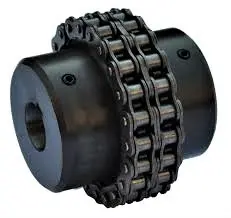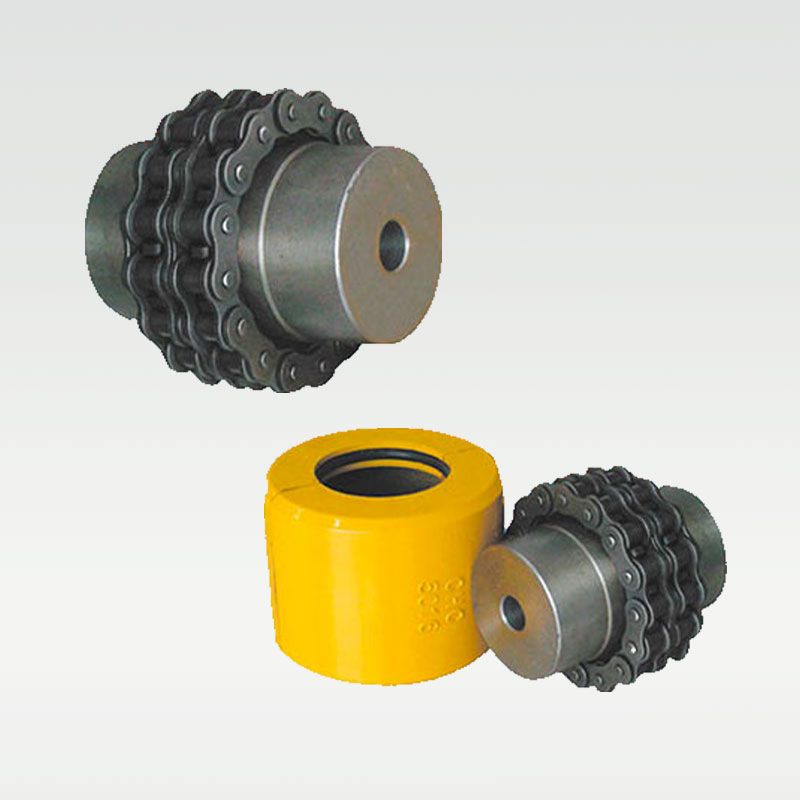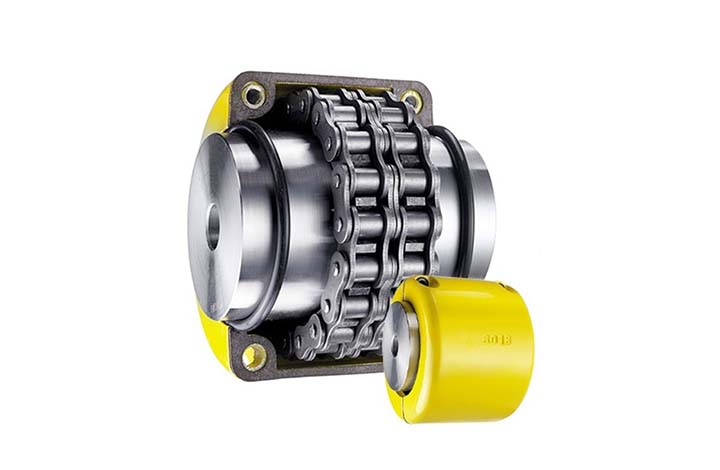Product Description
|
Chain |
Chain No. |
D Bore Dia | Dimension | Inertia
×10-3 kgf·m2 |
Approx Weight
kg |
Casing | ||||||||
| Min mm | Max mm | L
mm |
I
mm |
S
mm |
d1 mm |
d2 mm |
C
mm |
Dimension | Approx Weight
kg |
|||||
| A mm |
B mm |
|||||||||||||
| KC-5016 | 50-2X16 | 16 | 40 | 99.7 | 45.0 | 9.7 | 60 | 96 | 18.1 | 9.720 | 2.7 | 111 | 85 | 0.6 |
Chain couplings
The Chain coupling is composed of a duplex roller chain and a pair of coupling sprockets. The function of connection and detachment is done by the joint of chain. It has the characteristic of compact and powerful, excellent durability, safe and smart, simple installation and easy alignment. The Xihu (West Lake) Dis.hua Chain coupling is suitable for a wide range of coupling applications.
Roller chain( Coupling Chains)
Though Hans Renold is credited with inventing the roller chain in 1880, sketches by Leonardo da Vinci in the 16th century show a chain with a roller bearing.Coupling chains)Coupling chains
Roller chain or bush roller chain is the type of chain drive most commonly used for transmission of mechanical power on many kinds of domestic, industrial and agricultural machinery, including conveyors, wire- and tube-drawing machines, printing presses, cars, motorcycles, and bicycles. It consists of a series of short cylindrical rollers held together by side links. It is driven by a toothed wheel called a sprocket. It is a simple, reliable, and efficient[1] means of power transmission.
| Chain No. | Pitch
P mm |
Roller diameter
d1max |
Width between inner plates b1min mm |
Pin diameter
d2max |
Pin length | Inner plate depth h2max mm |
Plate thickness
Tmax |
Transverse pitch Pt mm |
Tensile strength
Qmin |
Average tensile strength Q0 kN |
Weight per piece q kg/pc |
|
| Lmax mm |
Lcmax mm |
|||||||||||
| 4012 | 12.7-0-0. p. 211. Retrieved 17 May 2-0-0. p. 86. Retrieved 30 January 2015. Green 1996, pp. 2337-2361 “ANSI G7 Standard Roller Chain – Tsubaki Europe”. Tsubaki Europe. Tsubakimoto Europe B.V. Retrieved 18 June 2. External links Wikimedia Commons has media related to Roller chains. The Complete Xihu (West Lake) Dis. to Chain Categories: Chain drivesMechanical power transmissionMechanical power control Why Choose Us
Real-World Examples of Successful Roller Chain Coupling Installations and Benefits1. Industrial Conveyor Systems: Roller chain couplings are widely used in industrial conveyor systems to transmit power between the driving and driven shafts. They provide reliable torque transmission and can accommodate misalignments, ensuring smooth and efficient operation of the conveyor. The benefits include reduced downtime due to their robustness and the ability to handle heavy loads in demanding environments. 2. Heavy Machinery Applications: In heavy machinery such as mining equipment, steel mills, and large cranes, roller chain couplings play a crucial role in transmitting power from the motor to various mechanical components. The ability to withstand high torque and shock loads ensures the safe and efficient operation of these machines. Roller chain couplings’ durability reduces maintenance requirements and enhances overall system reliability. 3. Pumping Systems: Roller chain couplings are used in pumping systems for various industries, including water treatment, oil and gas, and chemical processing. They offer the advantage of absorbing vibration and shock loads, contributing to the smooth and continuous operation of pumps. Their flexibility allows them to compensate for any misalignment between the motor and pump shafts, reducing stress on the equipment and increasing its lifespan. 4. Paper and Pulp Industry: In the paper and pulp industry, roller chain couplings are employed in various applications, including paper machines and pulp processing equipment. Their ability to handle high-speed and high-torque requirements makes them suitable for demanding tasks. Roller chain couplings contribute to reduced maintenance costs and improved productivity by ensuring efficient power transmission in critical processes. 5. Automotive Manufacturing: Automotive manufacturing plants use roller chain couplings in assembly line machinery and robotic systems. The couplings help in providing precise power transmission, ensuring accurate and synchronized movement of equipment. This results in improved production efficiency and reduced downtime, leading to cost savings and enhanced manufacturing output. Overall, roller chain couplings have demonstrated their effectiveness and versatility across various industries. Their ability to handle misalignments, shock loads, and high torque makes them an excellent choice for demanding applications where reliability and efficiency are critical. “` Specialized Roller Chain Couplings for High-Torque or High-Speed ApplicationsYes, there are specialized roller chain couplings designed to handle high-torque or high-speed applications. These specialized couplings are engineered to meet the specific demands of such industrial scenarios. Here are some key features and considerations for high-torque or high-speed roller chain couplings:
When selecting a roller chain coupling for high-torque or high-speed applications, it is essential to consider the specific operating conditions, torque requirements, rotational speeds, and any other factors that might impact the coupling’s performance. Consulting with coupling manufacturers or engineering experts can help identify the most suitable coupling for a particular application.
What is a Roller Chain Coupling and How Does It Function in Mechanical Power Transmission?A roller chain coupling is a type of flexible coupling used in mechanical power transmission systems to connect two shafts and transmit torque between them. It consists of two sprockets, one on each shaft, and a roller chain that meshes with the sprockets. The functioning of a roller chain coupling is as follows:
Roller chain couplings are known for their reliability, simplicity, and ability to handle high torque loads. They are widely used in various industrial applications, including conveyor systems, pumps, mixers, and other equipment that require reliable torque transmission.
| |||||||||||




